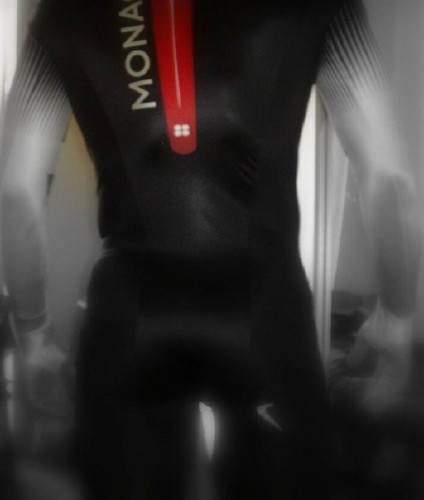Surely by coïncidence, most of my “friends” as designated “on the Facebook” are bobsledders. Some are Republicans, Christians, Harperites, Monacans, Utahans, Australians, Calgarians, Moroccans, or some combination thereof.
(Incidentally, what is it with Monaco and bobsleigh? In the principality that A.A. Gill derides so much, bobsleigh is to the winter Olympics as equestrian is to the summer.)
A bobsledder is pretty much guaranteed to be a weightlifting sprinter in tip-top condition. The skinniest ones weigh 200 pounds soaking wet in a Speedo, which means that the gold-medal podium at Nagano, where Italy and Canada actually tied for first, groaned under the weight of 830 pounds of bobsledder.
As with sports heavily reliant on equipment, bobsleigh is almost entirely pointless (a plus), and, like car racing, there isn’t much to recommend it as a spectator sport. Nonetheless, nontrivial bobsleigh photography is achievable, as wee Moroccan French Monacan bobsledder Anas Adoui (no relation) demonstrates.
There are barely any big, strong, tall sprinters in the world. You might be some of those, but you need all of them to push a sled. The kind of guy who might be biomechanically suited to bobsleigh is the same kind of guy who is socially more suited to football or hockey (or just spending an hour a half a day in the weight room). Bobsleigh “federations” worldwide are constantly short of athletes.
Are they looking in the wrong place?
In the vein of a previous freakonomics study (does wymmynz body size keep them off male hockey teams?), I wanted to do some research on the following question: Could athletes with certain disabilities succeed in bobsleigh?
On the surface, the answer is yes.
- A single-leg amputee almost couldn’t possibly run fast enough to push a sled. Getting into the sled fast enough would be difficult with a prosthesis, which might just fall off. So let’s eliminate them.
- Paralysis pretty much knocks you out of consideration, too, as would many kinds of cerebral palsy (maybe not upper-limb).
- A single-arm amputee, I contend, could push a bobsleigh – maybe not as brakeman, where you have to hold on to both sides of the back of the sled and pull two cords to stop it, but easily any of the other positions. You’d want to stay on the side of your good arm to reduce torque. Just barely possibly, you could even drive.
- Severe visual impairment knocks you out of contention, but minor visual impairment doesn’t.
- You could probably be stone deaf and still work on the team. There would be some adaptation required at starts, which tend to be cued by sound (i.e., by big, strong 200-pound guys hollering).
If you’re running a bobsleigh team and you’re in dire need of colossi, then you aren’t hiring on the ability to count to 20 on their fingers and toes, or drive a bus, or hum a single jam by the Dave Matthews Band. You’re accustomed to having perfect specimens all around you, but I thought you were hot for performance.
So I started doing research. I have a line on sprint times for any number of relevant disability classes in the Paralympics. To do a reasonable comparison, I needed some kind of clue about the sprint times bobsleigh coaches are looking for – “if you can run the 50 metres in x seconds, we want to talk to you” type of thing. (The recruiting pages I’ve seen – e.g., Bobsleigh Idol™ – aren’t specific enough.)
I sent along various requests, and even got an acknowledgement once. But since then, bupkes.
How am I supposed to solve your problem here if you aren’t gonna help me?
And yes, of course there is such a thing as wymmynz bobsleigh. Wow, do I ever not really care.
